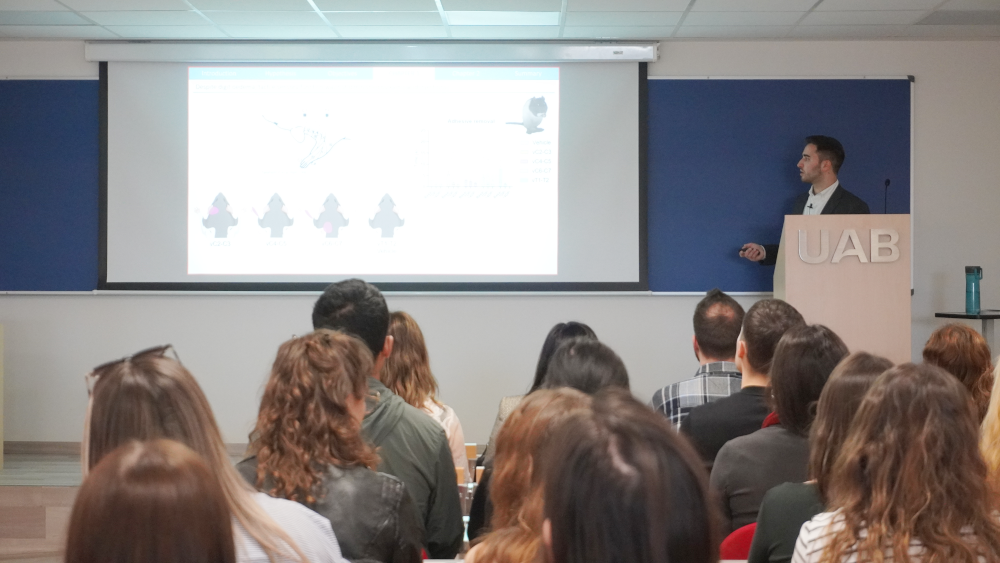A PhD experience: Dr. Diego López
"In this thesis, we focused on one of the most representative forms of motor control: reaching and grasping".

Movement is the foundation of life. It’s a constant part of our everyday lives. Think about it for a moment: when we get out of bed, movement; when we prepare breakfast, movement; when we eat it, movement; when we go to school, university, or work, movement; when we type on a keyboard or use our phone, movement; when we talk, movement; when we go to the gym, movement (well, some people more than others). Everything is movement!
But how does my body manage to coordinate all this movement almost automatically and as fast as a blink (which, yes, is also movement)? The answer lies in the motor system, which includes all our muscles (nearly 700 of them!) and the nervous system that controls them. This network receives sensory information from the environment (visual, auditory, tactile, etc.) to constantly adapt to changing conditions, like when we walk across uneven ground, for example.
In this thesis, we focused on one of the most representative forms of motor control: reaching and grasping. We use this movement all the time, for instance, when we pick up a glass of water to drink. Traditionally, this fine movement was thought to be controlled exclusively by the brain, with the spinal cord acting as a simple highway for transmitting the brain's orders to the muscles. However, it’s now known that the spinal cord is much more than just a highway, it also contains a neural network that controls locomotion. So, our hypothesis was that the spinal cord contains a neural network necessary for controlling the movement of reaching and grasping.
Now, do you have any idea how we can test whether this hypothesis is true? In science, to understand the function of something, we often observe what happens when it’s missing. So, we injected small amounts of kainic acid, a toxic compound that destroys neurons, into different levels of the spinal cord in rats. We assessed their skilled and unskilled manual function using various behavioral tests, including reaching and grasping, manipulating a donut-shaped cereal, removing adhesive tape from their palms, and locomotion. If, after injecting kainic acid into a specific spinal region, we saw impairments in reaching and grasping, it would suggest that the necessary neural network was located there.
Surprisingly, we found that animals injected with kainic acid in the C3 spinal segment lost the ability to perform reaching and grasping movements, while other manual functions remained unaffected. We had found our candidate spinal network for controlling reaching and grasping.
From there, our next step was to investigate this network in segment C3. First, we wanted to determine what types of neurons made up the network. The spinal cord mainly contains three types: motor neurons (which trigger muscle contractions), sensory neurons (which transmit sensory information to the spinal cord), and interneurons (the vast majority, which connect and coordinate the other two types). Since rats in which we had removed motor and sensory neuron connections in C3 could still perform the reaching and grasping task normally, we concluded that the network was composed of interneurons.
In another experiment, we compared the number of active neurons in different spinal segments while the animals were reaching and grasping, walking, or doing nothing with their forelimbs. We saw that significantly more interneurons were activated in C3 during the reaching and grasping movement.
Finally, we asked ourselves how this network actually controls the movement. Our hypothesis was that it might do so by influencing the motor neurons in the C7 segment, since these are responsible for contracting many of the upper limb muscles. How could we test that? You’ve probably guessed it by now: by seeing what happens when those connections are absent. Using genetic engineering, we were able to specifically and selectively inactivate only the C3 neurons that projected to C7 motor neurons. Fascinating, right? However, this inactivation had no effect on manual function. So, the C3 network does not control reaching and grasping by directly regulating C7 motor neurons.
How does it work, then? We don’t know yet, but we’ll keep investigating. That’s one of the most beautiful things about science: it never ends. Every answer opens up new questions. But one thing is clear: the spinal cord is not just a highway; it houses a neural network in the C3 segment that is necessary for performing reaching and grasping movements.
Understanding the mechanisms by which our motor system controls movement is key to improving therapies for people with motor disorders, such as spinal cord injury or stroke. For them, even a small improvement in hand function can mean a huge leap in their quality of life. We’ll get there!
Diego López Santos